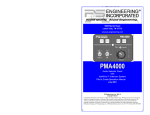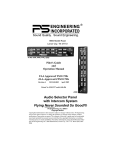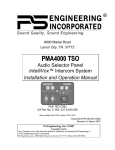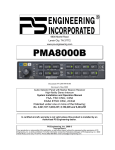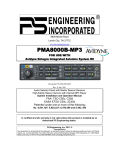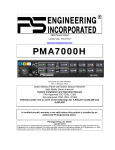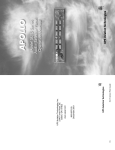Download PS Engineering PMA4000 TSO User manual
Transcript
9800 Martel Road Lenoir City, TN 37772 www.ps-engineering.com Flying Never Sounded So Good!™ PMA4000 Pilot’s Guide/Operation Manual Audio Selector Panel with 4-place IntelliVOX® Intercom System FAA-TSO C50c Patented under one or more of the following; No. 5,903,277; 6,160,496 and 6,493,450 202-041-0000 Rev 1 PMA4000 TSO Pilot Guide & User Manual May 2004 1 General Instructions SCOPE This section provides detailed operating instructions for the PS Engineering PMA4000 Audio Selector Panel/Intercom Systems. Please read it carefully before using the equipment so that you can take full advantage of its capabilities. This section is divided into three sections covering the basic operating areas of the PMA4000 systems. They are: Audio Selector, Transceiver Selection and Intercom. Approval Basis The PMA4000 Audio Selector Panels (P/N 11942) are FAA approved under TSO C50c (Audio Amplifiers). Audio Selector Through the use of four latched, push-button, back-lit switches, it is possible to select any or all receiver audio. When selected, an internal backlight will illuminate indicating which audio source is selected. The Com toggle switch controls what transceiver is being heard by the pilot and copilot. "C1" (Com 1) and "C2" (Com 2) push-buttons select the receiver, and are used to monitor a com that is not selected for transmit. You will always hear the audio from the transceiver that is selected by the 2-position mic selector toggle switch. The users can identify which receivers are selected by noting which pushbutton switches are illuminated. Push buttons labeled N1 (Nav 1), N2 (Nav 2) are "latched" type switches. When one of these buttons is pressed, it will stay in the "in" position. Press the switch again and it be in the "out" position and remove that receiver from the audio. While selected, an internal lamp will also annunciate the switch. 2 PMA4000 TSO-Pilot Guide & User Manual Intercom Mode Selector Switch Unit power is turned on and off by the mode selector switch. In the OFF or "FAIL-SAFE" position, the pilot is connected directly to Com 1 allowing transmit and receive capability regardless of unit condition. Any time power is removed or turned OFF, the audio selector will be placed in the failsafe mode. The switch is a 3-position mode switch that allows the pilot to tailor the intercom function to best meet the situation. ISO: (Up Position): The pilot is isolated from the intercom and is connected only to the aircraft radio. He will hear the aircraft radio reception (and sidetone during radio transmissions if provided by the transceiver). Copilot and passengers will hear the intercom and music on Entertainment input, but not the aircraft radio receptions or pilot transmissions. ALL: (Middle Position): All parties will hear the aircraft radio, intercom, and music from entertainment input. However, during any intercom communications, the music volume automatically decreases when SoftMute is active . The music volume increases gradually back to the original level after communications have been completed. Speaker Amplifier Pressing the volume control will activate the cockpit speaker. This switch will place all selected audio on the cockpit speaker when selected. The speaker is automatically muted when the radio push to talk (PTT) is active. To reduce power consumption and internal heat buildup, switch off the speaker amplifier when not in use. Microphone (Transmit) Selector Switch Microphone Selector The up switch position is COM 1. Both pilot and copilot will be connected to the Com l transceiver. While in the COM 1 or COM 2 mode, the intercom functions normally. Both the pilot and copilot have transmit capabilities on the selected transceiver. All hear the selected audio if the intercom is in the ALL mode. Only the person who presses their Push To Talk (PTT), will be heard over the aircraft radio. Placing the toggle switch in the COM 2 position will place pilot and copilot on Com 2. The PMA4000-Series has an automatic selector mode. Audio from the sePMA4000 TSO Pilot Guide & User Manual 3 lected transceiver is automatically heard in the headsets and speaker (when selected). You can check this function by switching from COM 1 to COM 2 and watch the selected audio light on the selector change from C1 to C2. This ensures the pilot will never transmit on a radio is not listening to. When switching from COM 1 to COM 2 while Com 2 has NOT been selected, Com 1 audio will be switched off. In essence, switching the mic selector will not effect the selection of Com receiver audio. Volume Control The pilot volume control knob adjusts the loudness of intercom and music in the pilot’s headphones only. It has no effect on selected radio audio levels. The copilot volume control adjusts the loudness of the intercom and music in the copilot headset. The passenger volume is also adjusted by the copilot volume control. Most general aviation headsets have a built-in volume control, so volume can be adjusted “locally.” The copilot volume control is also controllable through the rear connector, so a tandem aircraft can adjust the volume from a different location. VOX-Squelch Control The PMA4000 incorporates PS Engineering’s revolutionary IntelliVox® No adjustment of the squelch control is required. Through two individual signal processors, the ambient noise appearing in all four microphones is constantly being sampled. Non-voice signals are blocked. When someone speaks, only their microphone circuit opens, placing their voice on the intercom. The system is designed to block continuous tones, therefore people humming or whistling in monotone may be blocked after a few moments. For best performance, the headset microphone must be placed within ¼ inch of your lips, preferably against them. It is also a good idea to keep the microphone out of a direct wind path. Moving your head through a vent air stream may cause the IntelliVox® to open momentarily. The IntelliVox® is designed to work with normal aircraft cabin noise levels (70 dB and above). It loves airplane noise! Therefore, it may not recognize speech and clip syllables in a quiet cabin, such as in the hangar, or without the engine running. This is normal. For optimum microphone performance, PS Engineering, Inc. recommends installation of a Microphone Muff Kit from Oregon Aero (1-800-8886910). This will not only optimize VOX performance, but will improve the overall clarity of all your communications. 4 PMA4000 TSO-Pilot Guide & User Manual Intercom Modes Mode Pilot Hears Copilot Hears Passenger Hears Comments ISO A/C Radio Copilot Copilot Passengers Pilot Sidetone Passengers (during radio Entertainment Entertainment transmission) This mode allows the pilot to communicate with the air traffic control without the copilot or passengers bothered by the conversations. Copilot and passengers can continue to talk and listen to music All Radios Sidetone Pilot Copilot Passengers Entertainment This mode allows all on board to hear radio reception as well as communicate on the intercom. Music and intercom is muted during intercom and radio communications Radios Sidetone Pilot Copilot Passengers Entertainment Radios Sidetone Pilot Copilot Passengers Entertainment The audio selector panel has provisions for an entertainment input device. While in the ISO (Isolate) mode, only the copilot and the two passengers will hear entertainment device. In normal operation, whenever a person speaks or if the aircraft radio becomes active, the music will automatically mute and then will gradually return to the original listening level when the radio or intercom activity ceases. If a stereo entertainment device is used, the left and right channels can be combined in the plug to provide full sound. Push to talk intercom mode In some extremely high noise environments, it may be desirable to have a push to talk (PTT) intercom, instead of relying on voice-activation (VOX). In the PMA4000 audio panel the PTT intercom capability is added. To operate the PTT, Activate the panel-mounted VOX override switch. Then, the ICS PTT switch on the pilot or copilot side will allow voice on the intercom. Internal Recorder System (11941, only) The PMA4000 (part number 11941) has an available internal recorder option. This stores the last 60 seconds of radio traffic from the selected COM transceiver (the one selected for transmit). The recorder function is automatic. Pressing the momentary switch associated with the playback, will cause the last message to played (incoming PMA4000 TSO Pilot Guide & User Manual 5 radio and transmit sidetone). This will be heard in all headsets and speaker (if selected). To hear older messages, push the playback button repeatedly to “back up” the recorder, until the desired message is heard. Holding the IRS playback button for three seconds will stop the message playback and queues the system to the next preceding message. This allows quick access to previous messages. The recorder is a continuous loop, and newest ones will overwrite the oldest messages. The IRS has an internal squelch that prevents storing ‘dead’ air. A radio signal of more than 1 VRMS is needed to trigger the IRS. Therefore, if the IRS does not seem to be recording, increase the aircraft radio volume slightly. Limitations Any entertainment device connected through the PMA4000 must be switched off during take off and landing. Emergency Procedures In the event that the unit exhibits any anomalous behavior, such as an audio failure, transmitter failure, or other difficulty, the unit can be switched off in the following manner: 1. Placing the Intercom Mode Selector Switch (see Figure 1-2) into the “OFF” position. 2. Pulling the Audio Panel Circuit Breaker. This activates the fail-safe mode, which connects the pilot’s headset directly to Com 1. This allows communications or the pilot only, on Com 1 only. 6 PMA4000 TSO-Pilot Guide & User Manual Warranty and Service In order for the factory warranty to be valid, the installations in a certified aircraft must be accomplished by an FAA- approved agency, and authorized PS Engineering dealer. PS Engineering, Inc. warrants this product to be free from defect in material and workmanship for a period of one year from the date of installation. During this one-year warranty period, PS Engineering, Inc., at its option, will send a replacement unit at our expense if the unit should be determined to be defective after consultation with a factory technician. The customer is responsible for return shipment costs. This warranty is not transferable. Any implied warranties expire at the expiration date of this warranty. PS Engineering SHALL NOT BE LIABLE FOR INCIDENTAL OR CONSEQUENTIAL DAMAGES. This warranty does not cover a defect that has resulted from improper or unreasonable use or maintenance as determined by us. This warranty is void if there is any attempt to dissemble this product without factory authorization. This warranty gives you specific legal rights, and you may also have other rights that may vary from state to state. Some states do not allow the exclusion of limitation of incidental or consequential damages, so the above limitation or exclusions may not apply to you. Factory Service The PMA4000 is covered by a one-year limited warranty. See warranty information. Call PS Engineering, Inc. at (865) 988-9800 before you return the unit. This will allow the service technician to provide any other suggestions for identifying the problem and recommend possible solutions. After discussing the problem with the technician and you obtain a Return Authorization Number, ship product to: PS Engineering, Inc. Attn. Service Department 9800 Martel Road Lenoir City, TN 37772 (865) 988-9800 FAX (865) 988-6619. www.ps-engineering.com/suport.shtml If no method of payment is provided, the units will be returned COD. Units that arrive without an RMA number, or telephone number for a responsible contact, will be returned un-repaired. PS Engineering is not responsible for items sent via US Mail. PMA4000 TSO Pilot Guide & User Manual 7 PS Engineering, Inc. 2004 © Copyright Notice Copyrighted information in this manual is subject to change without notice. PS Engineering reserves the right to improve or change the products or contents of this manual, without notification of any person or agency. The contents of this pilot’s guide may be downloaded, stored and reprinted for personal use provided that this copyright information is included. Commercial use is strictly prohibited. For further information contact the Publications Manager at PS Engineering, Inc., 9800 Martel Road, Lenoir City, TN 37772. Phone (865) 988-9800 8 PMA4000 TSO-Pilot Guide & User Manual








